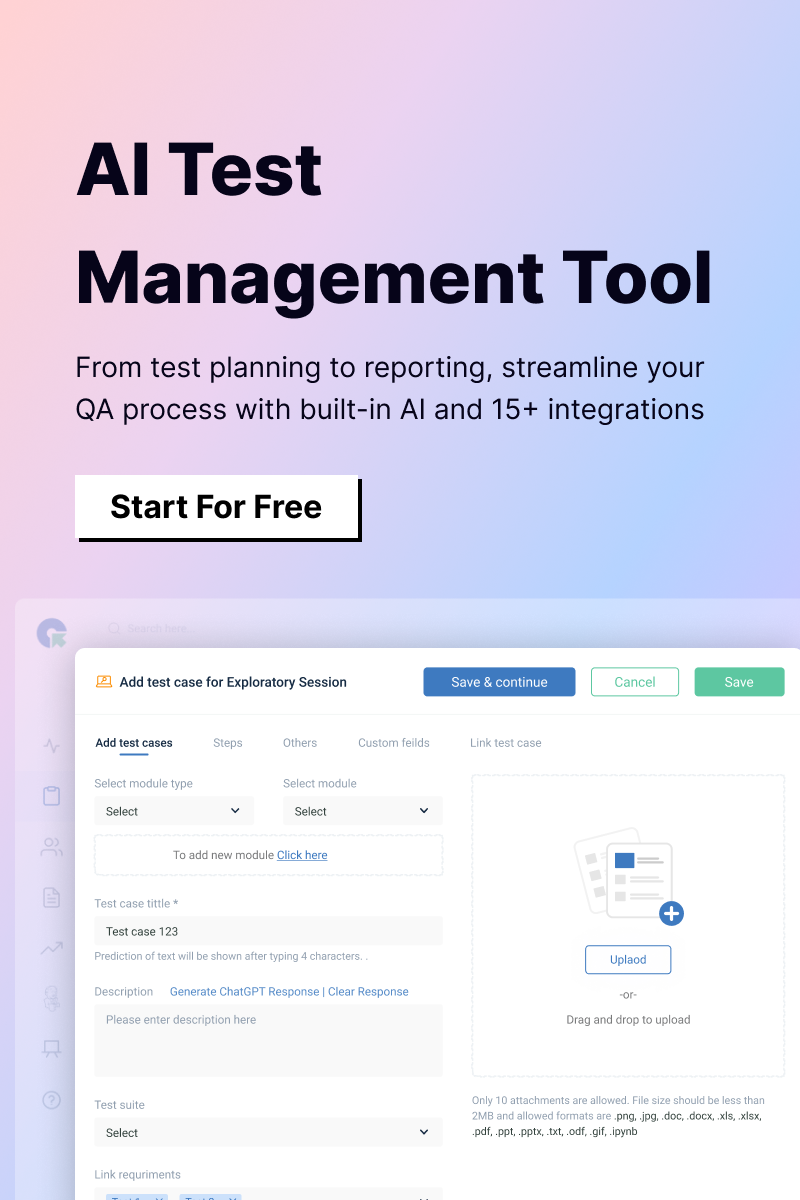What if you could catch defects before they become costly problems? Shift-Left Testing does that by moving testing earlier in the development cycle. Instead of waiting until the end, this approach incorporates testing from the start, leading to faster feedback, higher quality, and lower costs. Here, we’ll explore the origins of Shift-Left Strategy in Software Testing, why it matters in modern software development, and how you can implement it effectively.
What is Shift-Left in Software Testing?
Shift Left is a software testing approach that moves testing activities earlier in the software development lifecycle (SDLC). The term ‘Shift Left’ refers to shifting testing to the left on a project timeline. Traditional testing models often introduce delays, as defects discovered late in the cycle require significant rework.
With Shift-Left Testing, QA teams collaborate closely with development, product, and release teams for early defect detection and faster fixes. This approach integrates testing into development, unlike Shift-Right testing, which focuses on DevOps. By adopting this approach, teams can reduce errors and create a high-performing software delivery process.
Historical Context and Evolution
Shift Left is a software testing approach that emphasizes early and continuous testing in SDLC. The concept was first coined by Larry Smith in 2001 and is rooted in the principle of ‘test early and often’. In the early days of software development, the Waterfall model followed a sequential approach where testing was one of the final stages.
This often led to delayed detection of defects, costly fixes, and project errors. As software development evolved, Agile and DevOps methodologies introduced faster release cycles, iterative development, and continuous testing, making early testing essential for maintaining speed and quality.
Shift Left in Software Testing aligns with these modern methodologies, allowing teams to:
- Detect and fix defects earlier, reducing costs and rework.
- Improve collaboration between developers, testers, and operations teams.
- Support Continuous Integration/Continuous Deployment (CI/CD) pipelines for faster releases.
The Importance of Shift Left in Software Testing
In the present-day software development, delivering high-quality products quickly is a top priority. Shift Left in Software Testing achieves this by introducing testing earlier, making it a key practice in Agile and DevOps workflows. Shift Left Testing is important because:
- Early Defect Detection – Catching and fixing bugs early prevents costly rework later in the process.
- Improved Software Quality – Continuous testing ensures defects are addressed before release improving reliability.
- Faster Development Cycles – By identifying issues early, teams avoid last-minute mistakes, leading to faster releases.
- Cost Savings – Fixing bugs earlier in the lifecycle is significantly cheaper than resolving them post-release.
- Better Collaboration – Developers and testers work closely throughout the process for a more efficient and collaborative workflow.
Key Principles of Shift Left Software Testing
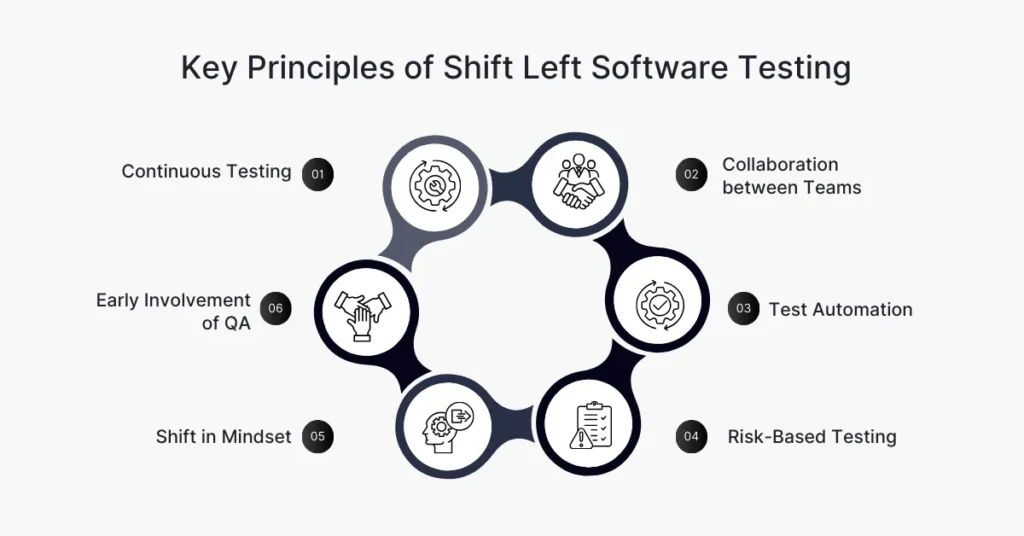
Shift-Left strategy in software testing is built on foundational principles that guide its successful implementation and aid the development process.
1. Continuous Testing
Testing should begin as early as possible in SDLC and continue throughout each phase. This prevents defects from accumulating and becoming costly to fix later.
2. Collaboration between Teams
Shift-Left Testing encourages close collaboration between developers, testers, and operations teams. By breaking down silos, teams can detect issues faster and align on quality goals from the start.
3. Test Automation
Automating tests, including unit, integration, and regression tests, ensures rapid feedback and consistent validation. Automation reduces manual effort and supports CI/CD pipelines.
4. Risk-Based Testing
Prioritizing testing based on risk helps teams to focus on high-impact areas of the application. By identifying critical functionalities and vulnerabilities early, organizations can lessen possible failures.
5. Shift in Mindset
Shift Left Testing is not just a process change—it’s a mindset shift. Developers take responsibility for quality by writing testable code and implementing practices such as Test-Driven Development (TDD) and Behavior-Driven Development (BDD).
6. Early Involvement of QA
In traditional development models, QA teams were brought in during the final stages of testing, often leading to delays, last-minute fixes, and costly rework. Shift left in software testing changes this by integrating QA from the start—ensuring quality is built into the software from day one.
Benefits of Shift Left in Software Testing
Adopting the Shift left in software testing practices provides numerous benefits that speed up software development processes. By shifting testing activities to earlier stages of SDLC, teams can increase quality and achieve faster delivery.
Improved Software Quality
Shifting testing to the early stages of development ensures that defects are identified and addressed before they escalate into major issues. By catching bugs early, teams can produce more stable and reliable software. Continuous feedback from testers during development also allows for early refinement, resulting in a product that aligns better with business requirements and user expectations. This proactive approach reduces the chances of critical failures in production, leading to a higher quality product.
Faster Time to Market
By integrating testing into the development process from the beginning, teams can identify and resolve issues quickly, minimizing delays that typically occur when testing is deferred until later in the lifecycle. Early and frequent testing, combined with automation, helps accelerate development cycles and reduces time-to-market. This enables companies to release products more rapidly, stay ahead of competitors, and meet customer demands faster.
Improved Teamwork
Shift left in Software Testing promotes a collaborative environment where developers, testers, and operations teams work together from the outset of the project. By involving all stakeholders early, communication improves, ensuring that requirements are clearly understood and that testing is integrated throughout the development cycle. This collaboration promotes shared ownership of quality, with everyone playing an active role in maintaining high standards.
Increased Efficiency
Finding and fixing defects earlier in the development process significantly reduces the cost and time spent on rework later on. Testing early helps catch issues and fewer defects are carried over to later stages, where they would be more expensive and time-consuming to address. Automated tests further increase efficiency by allowing repetitive tests to be run quickly and accurately, resulting in a great reduction in the time between releases. This leads to cost savings, boosts productivity, and lowers project costs.
Increased Satisfaction
One of the key benefits of Shift left in Software Testing is the faster delivery of high-quality software with fewer errors. The positive impact on delivery speed and quality ultimately leads to greater satisfaction from business partners and stakeholders. When they see the benefits of quicker releases and smoother processes, it reinforces the value of adopting the Shift-left strategy in software testing.
How to Implement Shift Left in Software Testing?
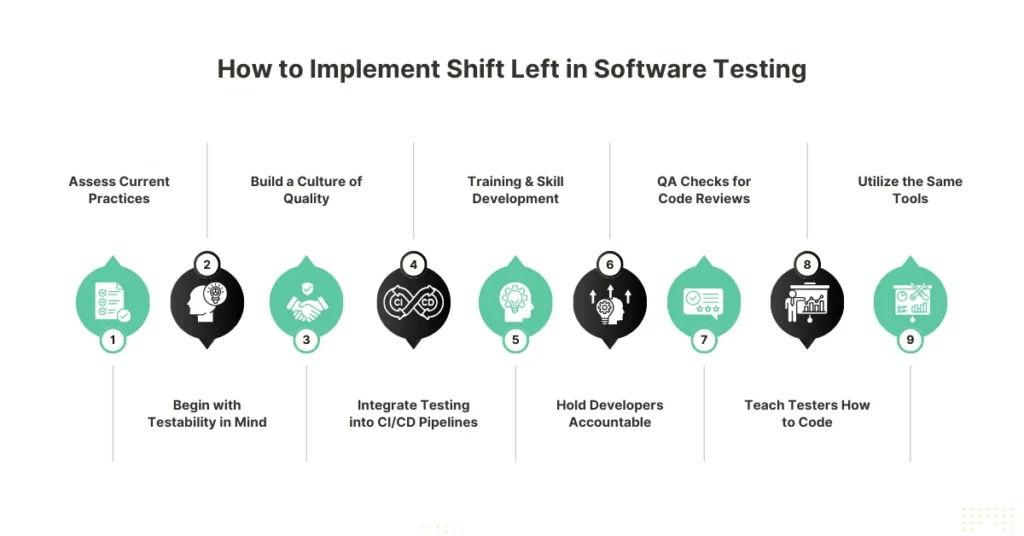
Adopting Shift left in Software Testing requires a strategic approach and commitment across the development lifecycle. By following the right steps and advancing a culture of collaboration and quality, organizations can successfully integrate this practice into their workflows. Here are key strategies for implementing Shift left in software testing:
Assess Current Practices
Before implementing Shift left in software testing, it’s important to evaluate the existing testing practices. Understand the current development cycle, testing processes, and where testing typically occurs in your organization’s workflow. Identify gaps and challenges that hinder efficiency and quality. By assessing these factors, you can determine the specific areas where early testing would have the most impact, ensuring a smoother transition to Shift Left in Software Testing practices.
Begin with Testability in Mind
From the very beginning of the development process, design the software with testability in mind. This ensures that components are easily testable, and quality assurance teams can efficiently verify functionality during the early stages of development. When testability is prioritized from the outset, it reduces the need for extensive rework later on, leading to a smoother testing process.
Build a Culture of Quality
Shifting left goes beyond just changing when testing is done—it involves nurturing a culture of quality across the entire team. Ensure that everyone, from developers to operations, views quality as a shared responsibility. Encourage open communication, continuous feedback, and a commitment to early issue identification and resolution. Promote the idea that quality is integrated throughout the development process, not just checked at the end.
Integrate Testing into CI/CD Pipelines
To fully utilize Shift left in software testing, integrate testing into your CI/CD pipelines. Automated tests should be executed every time a new code is committed for quick feedback and spotting of defects. This incorporation ensures that tests are run continuously throughout development and that any new changes are validated as they are made. By embedding testing within the CI/CD process, development teams can address issues quickly.
Training and Skill Development
Successful implementation of shift left in software testing requires upskilling teams to apply early testing practices. Training developers, testers, and other stakeholders in testing methodologies, test automation tools, and new processes is critical. The team members should be equipped with the knowledge and skills to identify and address defects early, use automated testing tools, and integrate testing into development workflows. Continuous skill development will empower teams to maintain high standards.
Encourage Collaboration
In a Shift-Left Software Testing environment, quality is a shared responsibility between developers and testers. Build collaboration by involving developers in test strategy discussions and encouraging them to write unit tests, conduct peer reviews, and address defects early. Likewise, testers should participate in the design phase to provide insights that improve testability. This approach leads to early issue detection and faster resolution.
QA Checks for Code Reviews
Implement quality checks during code reviews, where testers can inspect code for potential defects or areas for improvement. This process considers quality at every stage, not just after development is completed. By involving the testers early, risk of issues is addressed, leading to cleaner and more robust code.
Teach Testers How to Code
Encourage testers to learn coding skills, particularly in automation and scripting. This empowers them to create efficient tests and integrate them with development processes, leading to faster feedback loops and improved collaboration. A well-rounded team with both testing and coding expertise can improve productivity and reduce hindrances in the testing phase.
Utilize the Same Tools
Build collaboration between developers and testers by using the same tools throughout the development and testing phases. Shared tools for version control, test automation, and CI/CD pipelines help ensure smoother communication and faster defect detection. Unified tools create consistency across teams, ensuring everyone is on the same page, leading to more efficient workflows.
Tools for Shift-Left Software Testing
To make Shift-Left Software Testing work, using the right tools is essential. These tools help identify problems early in the development cycle, improving code quality and collaboration. Tools such as JUnit, Selenium, Jenkins, SonarQube, and GitLab CI simplify unit testing, integration testing, static code analysis, and continuous testing. For performance testing and real-device testing, platforms such as HeadSpin offer critical insights early, helping teams catch issues before they escalate into costly problems. The following tools are key enablers of Shift-Left Software Testing:
- Junit: A popular testing framework for Java applications, JUnit allows developers to write and run unit tests early in the development process.
- Simple integration with Java projects.
- Supports TDD practices. Best For: Unit testing, TDD in Java environments.
- JUnit + Selenium: Selenium is a robust tool for automating browser testing. When integrated with JUnit, it allows developers to write and execute UI tests early in development.
- Browser automation with support for multiple languages (Java, Python, C#).
- Ideal for functional and integration testing in web applications. Best For: Automated UI testing.
- JUnit + Mockito: Mockito is a Java framework for creating mock objects in tests, enabling developers to isolate and test individual components early.
- Simplifies unit testing by mocking dependencies. Best For: Unit testing with mock objects.
- Jenkins: Jenkins is a CI tool that automates build, test, and deployment processes, integrating tests into CI pipelines and supporting Shift-Left Software Testing practices.
- Automated testing and feedback loops.
- Integration with various testing frameworks (JUnit, TestNG). Best For: Automating early testing through CI/CD pipelines.
- GitLab CI/CD: GitLab’s integrated CI/CD platform enables developers to automate tests, from unit tests to full integration tests, running tests on every code commit.
- Automated testing triggered by code commits.
- Built-in pipelines for continuous testing. Best For: Continuous testing and Shift-Left Software testing.
- HeadSpin: HeadSpin is a performance testing and monitoring platform that supports Shift Left performance testing for mobile and web apps, integrating with CI/CD pipelines for early performance feedback.
- Real-device cloud testing.
- AI-driven performance insights. Best For: Shift-left performance testing on real devices.
- SonarQube: SonarQube is a static code analysis tool that detects code smells, bugs, and vulnerabilities early in the development process.
- Automated static analysis.
- Tracks code quality metrics. Best For: Static code analysis and code quality checks.
- TestNG: TestNG is a testing framework with advanced features such as test configuration and parallel execution, allowing developers to write more flexible tests.
- Supports unit, functional, and integration tests.
- Parallel execution and dependency testing. Best For: Advanced test configurations and flexible testing.
- Cucumber: Cucumber is a behavior-driven development (BDD) tool that enables developers to write tests in plain English, supporting collaboration between developers, testers, and business stakeholders.
- Write test cases in Gherkin (plain language).
- Facilitates BDD practices. Best For: BDD and early collaboration between business and development teams.
- Pylint (for Python projects): Pylint is a static code analysis tool for Python that helps developers identify coding errors, enforce coding standards, and find potential bugs early.
- Automated linting of Python code.
- Reports errors, style violations, and potential bugs. Best For: Python static code analysis.
Challenges of Shift-Left Strategy in Software Testing
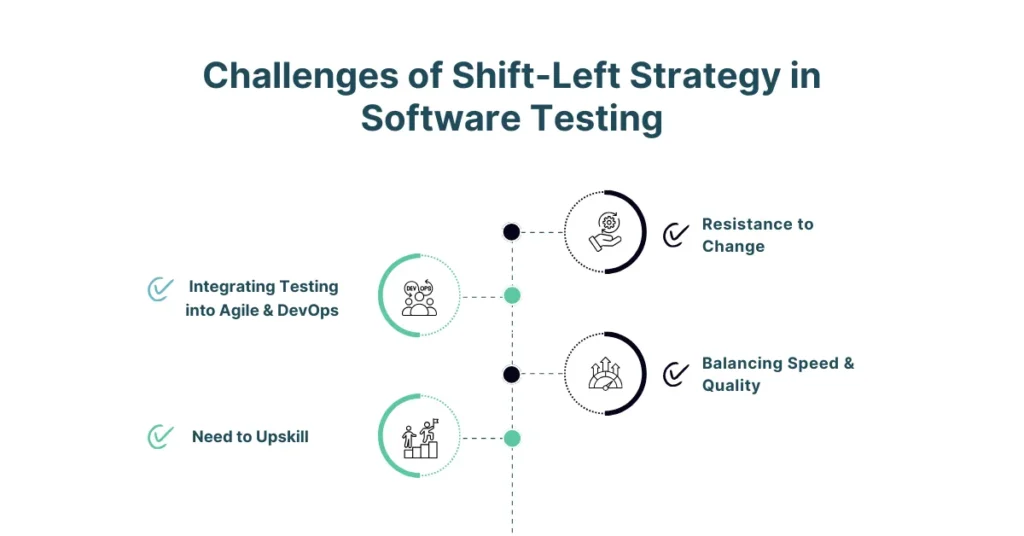
While Shift-Left Software Testing offers numerous benefits, organizations may face several challenges when implementing this approach. Here are some key obstacles:
Resistance to Change
Shifting testing earlier in the development process may face resistance from teams, accustomed to traditional testing methods. This shift requires cultural and mindset changes that may take time to adopt fully.
Balancing Speed and Quality
To speed up development, there’s a risk that teams may prioritize speed over thoroughness, potentially compromising the quality of tests and the product. Finding the right balance is crucial for success.
Need to Upskill
Adopting Shift-Left Software Testing often requires new tools and skills. Teams may lack experience with automated testing tools or integration with CI/CD pipelines, making it harder to implement these practices.
Integrating Testing into Agile and DevOps
Successfully integrating testing into Agile and DevOps workflows can be difficult. It requires joint efforts among development, operations, and testing teams, which may involve overcoming silos and simplifying communication.
Best Practices for Shift-Left Software Testing
Shift-left testing offers advantages over older test sequences only when the code is complete. Early detection of errors saves time and effort and is more cost-effective and convenient. Organizations should follow these best practices to make Shift-Left Software Testing useful:
Start Early
Begin testing as soon as requirements are defined and continue throughout the development lifecycle to catch issues early. This proactive approach helps detect defects before they become costly to fix. By involving QA from the start, teams can align testing goals with business objectives.
Define Clear Testing Objectives
Set clear goals for testing early in the development cycle. This helps teams align on expectations, identify defects sooner, and improve overall quality. Clear objectives also ensure that testing efforts remain focused and aligned with business priorities.
Develop a Collaborative Workspace
Encourage developers, testers, and stakeholders to work closely together. Open communication and shared responsibility for quality lead to better integration of testing. Regular stand-ups and knowledge-sharing sessions can further strengthen collaboration.
Utilize Automation
Use automated testing tools to speed up testing, reduce errors, and maintain consistency across test cycles. Automating repetitive tasks allows teams to focus on more complex test scenarios. Choosing the right automation framework ensures better test coverage and efficiency.
Utilize Test-Driven Development
Adopt TDD by writing tests before writing code. This approach ensures better test coverage, reduces defects, and strengthens software reliability. TDD also helps create modular and maintainable code, making future updates easier.
Adopt Agile Practices
Follow Agile methodologies to support continuous testing and iterative development for faster improvements. Agile promotes a test-first mindset, enabling teams to adapt quickly to changes. Frequent feedback loops ensure software quality remains a priority throughout development.
Invest in Training
Provide learning opportunities to help team members build the skills needed for early-stage testing. Regular training sessions on new testing tools and methodologies keep teams up to date. Encouraging a learning culture ensures that testing remains efficient and effective.
Use Static Code Analysis
Utilize static analysis tools to detect code issues before execution, reducing the chances of defects. Early detection helps improve code quality and prevents vulnerabilities. Integrating these tools into development workflows ensures continuous improvement in coding standards.
Implement CI/CD
Incorporate testing into CI/CD pipelines for fast feedback and smoother deployments. Automated testing in CI/CD ensures that every code change is verified before reaching production. This practice reduces deployment risks and speeds up release cycles.
Monitor and Measure Success
Track key metrics such as defect rates, test coverage, and issue resolution times. Continuous monitoring helps teams assess the impact of shift-left software testing and make data-driven improvements. Regular analysis of these metrics allows teams to identify mistakes and optimize processes.
Continuous Improvement
Regularly review and refine testing strategies. Learn from past challenges, adopt new tools and techniques, and ensure that testing evolves with development processes. Encouraging feedback loops within teams helps in adapting to changing project needs effectively.
Real-World Case Studies
Implementing shift-left software testing has enabled various organizations to raise software quality, reduce time-to-market, and achieve significant cost savings. Below are recent case studies demonstrating successful adoption across different industries:
1. Financial Services Firm Boosts Security
A prominent financial services firm adopted shift-left software testing to proactively address security vulnerabilities in its software applications. By integrating Static Application Security Testing (SAST) and Dynamic Application Security Testing (DAST) tools early in the development lifecycle, the firm identified and mitigated security issues before deployment. This significantly reduced the risk of security breaches and raised customer trust.
2. Retail Service Provider Reduces Defects
A US-based B2B retail service provider faced challenges with increasing defects as their application expanded. The company incurred a significant cost of approximately $17 million in bug fixes due to the defect being discovered late after the product had already been released to the market. To address this, the company adopted a shift-left strategy in software testing by building better communication between engineering teams and business stakeholders through regular requirement discussions. They also integrated automated testing and CI/CD pipelines. This approach reduced deployment issues and improved software quality.
3. Manufacturing Company Upgrades Application Performance
A global manufacturing company sought to modernize its legacy sales and service applications by migrating to a low-code platform. By implementing shift-left strategy in software testing, the company conducted testing in parallel with development, ensuring early detection of design issues. This strategy reduced data processing time by 50% and improved the efficiency of sales and service record maintenance across multiple regions.
Future Trends in Shift-Left Software Testing
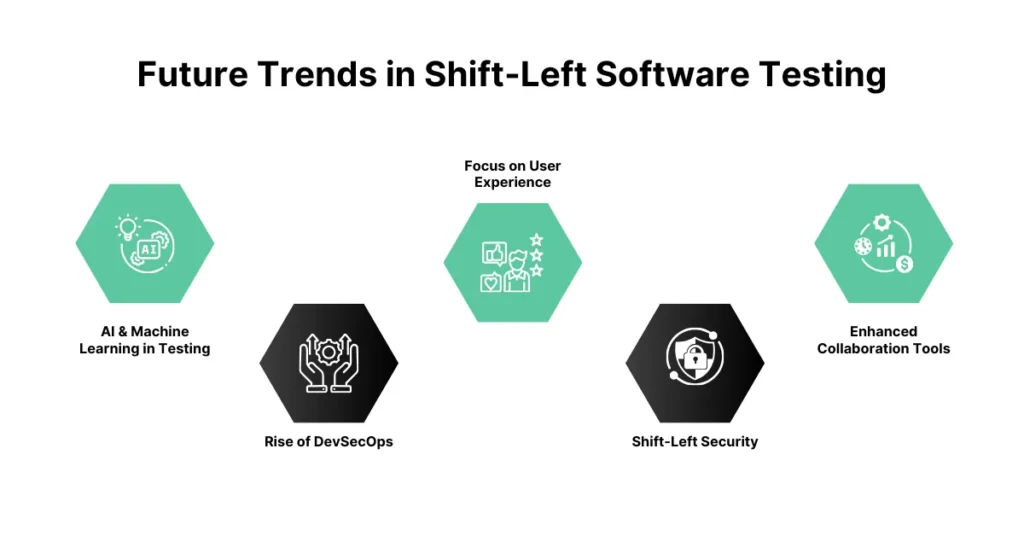
As software development continues to change, shift-left software testing will become even more critical in delivering high-quality software efficiently. Future trends in this space may include:
AI and Machine Learning in Testing
AI and machine learning are revolutionizing shift-left software testing by enhancing automation, predicting potential defects, and optimizing test execution. These technologies enable self-healing test scripts, intelligent test case generation, and real-time defect detection, making testing faster and more reliable. By analyzing historical data and user behavior, AI-driven testing helps teams anticipate issues before they impact production.
The Rise of DevSecOps
Security is becoming a critical focus in Shift-Left Software Testing, leading to the rise of DevSecOps. This approach integrates security testing early in SDLC, ensuring vulnerabilities are detected and addressed before deployment. Automated security scans, static code analysis, and continuous monitoring are helping organizations build robust and secure applications while maintaining speed and agility in development.
Focus on User Experience
As user expectations continue to rise, shift-left software testing is increasingly incorporating usability and accessibility testing from the start. Teams are prioritizing real-world user scenarios, performance benchmarks, and accessibility standards to create intuitive and inclusive applications. This proactive approach helps in delivering high-quality products that reinforce user satisfaction and engagement.
Shift-Left Security
Security testing will be embedded earlier in the development process to ensure vulnerabilities are addressed before they become critical. Automated static and dynamic security scans, threat modeling, and security-focused CI/CD pipelines will strengthen application security from the ground up.
Enhanced Collaboration Tools
Advanced collaboration tools will bridge the gap between developers, testers, and other stakeholders, nurturing a shared responsibility for quality. AI-powered project management, real-time code reviews, and integrated communication platforms will simplify workflows, improving efficiency and coordination.
Final Thoughts
Shift-Left in Software Testing is transforming software quality assurance by integrating testing earlier in the SDLC. While challenges exist, the benefits of Shift-Left in Software Testing make it a valuable approach for modern software development teams. The future of software testing lies in proactive and partnership approaches, and Shift-Left in Software Testing is at the forefront of this transformation.
At QA Touch, we empower teams to integrate testing into every phase of the development lifecycle. Our tools are designed to help you collaborate more effectively, automate your testing processes, and ensure top-quality results from the very beginning.
Connect with us today to see how QA Touch can help you implement Shift-Left strategy in Software Testing practices and upgrade your software quality.



